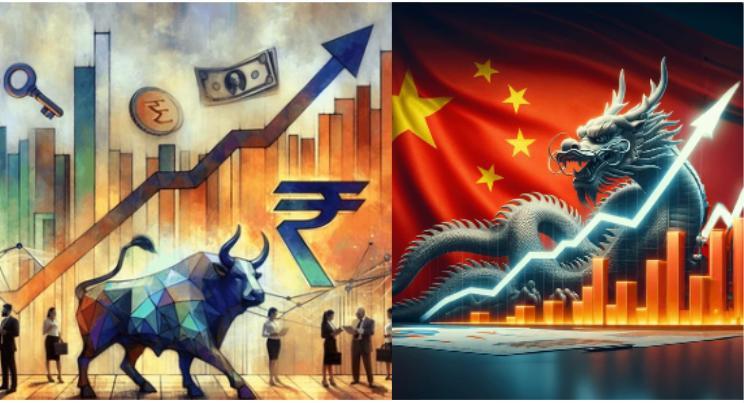
In recent times, two Asian titans – China and India – have come important players in the global economy. When China, known as the” dragon,” decides to fit plutocrat into its economy through encouragement packages, it sends ripples across global requests, including India’s, which is represented by the” bull.” India’s profitable growth is frequently likened to a bull request, charging forward with optimism. But with China’s new profitable measures, how will the Indian request respond? Let’s take a near look at this profitable face- off and what it could mean for investors, diligence, and consumers in India.
COVID- 19 Aftermath Like utmost countries, China’s economy was affected by the COVID-
The Chinese government has introduced multiple rounds of economic stimulus packages in response to its economic slowdown. The main reasons for this include:
- COVID-19 Aftermath: Like most countries, China’s economy was affected by the COVID-19 pandemic, leading to disruptions in manufacturing, supply chains, and exports.
- Global Slowdown: With slowing demand worldwide, Chinese exports have faced challenges, impacting sectors like manufacturing and technology.
- Real Estate and Debt Issues: China’s real estate sector, a significant part of its economy, is facing financial strain with high debt and issues in major property companies. This has led to a need for intervention to stabilize the sector.
- Domestic Demand: China’s government wants to increase consumer spending to boost the domestic economy and reduce its reliance on exports.
To tackle these issues, China’s government has implemented stimulus packages. These packages typically include measures like tax cuts, subsidies, interest rate cuts, and increased government spending on infrastructure projects. The goal is to boost domestic demand, keep the economy growing, and stabilize critical industries. However, these efforts to boost the Chinese economy also have global effects, including on India.
How China’s encouragement Affects the Indian Market
While China’s encouragement sweats aim to boost its economy, they also have circular goods on India, for better or worse.
1. Commodity Prices
China is one of the largest importers of raw materials like essence, oil painting, and coal. When China boosts its economy, it generally means it’ll demand further of these coffers. This increased demand can drive up global commodity prices, affecting Indian businesses and consumers. For illustration
Positive Impact -Advanced global demand for goods could profit Indian essence and mining companies, as they may see advanced gains from rising prices.
Negative Impact– Rising prices for oil painting and gas, which India significances heavily, could increase costs for Indian companies and consumers, leading to affectation. This can be especially challenging for India, where energy costs are formerly high.
2. Impact on Exports
China’s encouragement could potentially lead to increased competition for Indian exports in crucial sectors like electronics, fabrics, and ministry. China’s bettered manufacturing and import capabilities, boosted by its profitable measures, could make it tougher for Indian companies to contend. still, there’s another side occasion If China focuses more on domestic growth, Indian exporters could gain a larger share in global requests, especially in regions looking to diversify down from China.
Trouble If China increases subventions or support for its import sectors, Indian exporters may face tougher competition in requests where they preliminarily had an edge.
3. Currency Movements
One effect of encouragement packages can be changes in currency value. China’s sweats to boost its economy may lead to a weaker yuan( China’s currency) relative to the bone . A weaker yuan makes Chinese goods cheaper on the global request, which could attract foreign buyers toward Chinese products rather of Indian products.
For India Export Challenge Indian exports might struggle if the rupee remains strong while the yuan weakens, making Chinese goods more affordable encyclopedically.
Investment Impact The weaker yuan could also impact foreign investment overflows, as some investors may choose China over India for cheaper returns or vice versa, depending on how stable India’s economy appears in comparison.
Sectors in India Likely to Be Affected
Manufacturing
Indian manufacturers, especially in electronics, chemicals, and fabric will face further competition if China boosts product through subventions and impulses. still, sectors like medicinals, where India holds a strong position, might not be as affected.
Real Estate
China’s real estate request is massive, and if its government helps stabilize it, demand for construction accoutrements like sword and cement could rise. Advanced global prices for these materials may affect Indian construction and real estate companies, potentially adding costs and impacting profit perimeters.
Technology
China is a leader in technology and invention, particularly in electronics and mobile phones. Chinese encouragement could lead to a briskly development of technology products, impacting the Indian request, where Chinese electronics brands are formerly strong challengers.
Openings for the Indian Market
Despite challenges, China’s encouragement can open doors for India. Several factors could profit the Indian economy force Chain Diversification With companies looking to diversify force chains down from China, India could come an volition. India’s government has launched its product- Linked incitement( PLI) schemes to encourage manufacturing in sectors like electronics, medicinals, and automotive. This could attract businesses seeking a dependable, diversified manufacturing base
Foreign Investment
Investors might see India as a stable volition, especially if China’s economy faces prolonged issues or political challenges. A steady Indian request, withpro-growth reforms, could attract foreign direct investment( FDI).
Bilateral Trade and hookups
India could strengthen its profitable ties with countries that are looking to reduce dependence on China, especially in Asia and Europe. This may involve increased trade agreements, particularly in medicinals, husbandry, and IT services.
What Lies Ahead for Investors?
For investors, China’s encouragement packages present both openings and pitfalls in Indian requests. Then are some effects to consider Watch Commodity Prices Rising oil painting or essence prices can impact affectation and profit perimeters in India, impacting sectors like energy, manufacturing, and construction.
Diversify Portfolio
As India and China navigate their profitable strategies, diversifying into sectors less impacted by Chinese competition – suchlike IT services, medicinals, and consumer goods – might be wise.
Focus on Domestic Growth Sectors
India’s domestic consumption is growing, and sectors like FMCG( presto- moving consumer goods), fiscal services, and structure offer growth openings, kindly insulated from China’s profitable oscillations.
Conclusion
The battle between the Chinese dragon and Indian bull is a unique profitable face- off, impacting requests across Asia and the world. China’s encouragement packages are designed to strengthen its economy, but the performing shifts in commodity prices, currency values, and import competition can produce both challenges and openings for India.
As the two countries grow and acclimatize, Indian requests must stay flexible and nimble to navigate these global profitable changes. Investors, companies, and policymakers will need to stay informed, plan strategically, and balance pitfalls and prices to profit from the Asian profitable geography.

